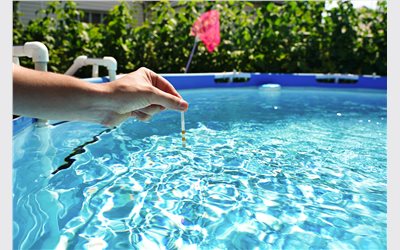How to Increase pH in Your Pool: A Comprehensive Guide
Maintaining the proper pH level in your swimming pool is crucial for ensuring a safe and enjoyable swimming experience. If the pH level drops too low, it can lead to a variety of problems, including skin irritation, corrosion of pool equipment, and ineffective sanitization. This comprehensive guide will explore how to increase the pH in your pool, the importance of pH balance, methods for raising pH, and safety considerations.
Table of Contents
- Understanding pH in Pools
- Importance of Maintaining Proper pH Levels
- Signs of Low pH Levels
- How to Test pH Levels
- Methods to Increase pH in Your Pool
- 5.1. Using Soda Ash
- 5.2. Using Baking Soda
- 5.3. Using pH Increaser Products
- 5.4. Aeration Method
- Calculating the Amount of Chemical Needed
- Safety Considerations
- Preventative Measures
- Conclusion
- FAQ Section
- References
1. Understanding pH in Pools
pH is a measure of how acidic or alkaline water is, measured on a scale from 0 to 14. A pH of 7 is considered neutral, while values below 7 indicate acidic conditions, and values above 7 indicate alkaline conditions. For swimming pools, the ideal pH range is typically between 7.4 and 7.6. This range is optimal for swimmer comfort and the effectiveness of chlorine as a disinfectant.
2. Importance of Maintaining Proper pH Levels
Maintaining the correct pH level in your pool is essential for several reasons:
- Swimmer Comfort: Water that is too acidic (low pH) can cause skin irritation and stinging eyes. Conversely, water that is too alkaline can also lead to discomfort.
- Equipment Longevity: Low pH can lead to corrosion of metal components, such as ladders, railings, and pool heaters. High pH can cause scaling and buildup on surfaces and equipment.
- Effective Sanitization: Chlorine and other sanitizers work best within a specific pH range. If the pH is too low or too high, the effectiveness of these chemicals can be compromised, leading to potential health risks.
- Algae and Bacteria Growth: Improper pH levels can create an environment conducive to the growth of algae and bacteria, making it essential to keep pH balanced.
3. Signs of Low pH Levels
Recognizing the signs of low pH levels can help you address the issue before it leads to more significant problems. Common indicators include:
- Skin Irritation: Swimmers may experience itchy skin or rashes after swimming.
- Stinging Eyes: Swimmers may complain of stinging or burning eyes.
- Corrosion: Metal fixtures in the pool may show signs of rust or corrosion.
- Cloudy Water: Low pH can lead to cloudy or unclear water due to the growth of algae or bacteria.
- Increased Chemical Usage: If you find yourself adding more chlorine than usual, it may be due to low pH levels affecting the sanitizer’s effectiveness.
4. How to Test pH Levels
Before attempting to adjust the pH in your pool, it’s essential to test the current levels accurately. Here are common methods for testing pool pH:
- pH Test Strips: These strips are easy to use and provide quick results. Simply dip the strip into the water and compare the color to the provided chart.
- Liquid Test Kits: These kits involve adding a reagent to a water sample and comparing the resulting color to a chart. They are generally more accurate than test strips.
- Digital Testers: These electronic devices provide precise readings of pH and other chemical levels in the water.
Testing your pool water at least once a week is recommended, especially during peak swimming season or after heavy rain.
5. Methods to Increase pH in Your Pool
If your pool’s pH is too low, there are several methods to raise it effectively:
5.1. Using Soda Ash
Soda ash, also known as sodium carbonate, is one of the most common chemicals used to raise pH levels in pools.
How to Use Soda Ash:
- Calculate the Amount Needed: The general rule of thumb is to add 6 ounces of soda ash per 10,000 gallons of water to raise the pH level by 0.2.
- Dissolve the Soda Ash: Mix the soda ash in a bucket of water before adding it to the pool to help it dissolve more quickly.
- Add to the Pool: With the pump running, pour the dissolved soda ash evenly around the pool to ensure proper distribution.
- Wait and Test: Allow the water to circulate for at least 20 minutes before retesting the pH level.
5.2. Using Baking Soda
Baking soda (sodium bicarbonate) can also be used to raise pH levels, although it primarily increases total alkalinity.
How to Use Baking Soda:
- Calculate the Amount Needed: Typically, 1.5 pounds of baking soda per 10,000 gallons of water will raise alkalinity by about 10 ppm. If the pH is below 7.2, you may need to add 3-4 pounds.
- Add Baking Soda: Sprinkle the baking soda directly into the pool while the pump is running to help it dissolve evenly.
- Wait and Test: Allow the water to circulate for at least 6 hours before retesting the pH level.
5.3. Using pH Increaser Products
Many pool supply stores offer commercial pH increaser products specifically designed to raise pH levels.
How to Use pH Increaser:
- Read the Instructions: Follow the manufacturer’s instructions for the specific product you are using, as concentrations and recommendations may vary.
- Add the Product: With the pump running, add the recommended amount of pH increaser directly to the pool.
- Wait and Test: Allow the water to circulate for the time specified in the product instructions before retesting the pH level.
5.4. Aeration Method
Aeration can help raise pH levels naturally by increasing the water’s exposure to air, which helps release carbon dioxide.
How to Use Aeration:
- Turn on the Pool Pump: Ensure the pool pump is running to facilitate water movement.
- Use Aerators or Fountains: If your pool has built-in aerators, fountains, or waterfalls, turn them on to increase water movement and exposure to air.
- Monitor pH Levels: Check the pH levels periodically to see if they are rising. This method may take longer than adding chemicals but is a natural way to adjust pH.
6. Calculating the Amount of Chemical Needed
To effectively raise the pH in your pool, you need to know the volume of water in your pool. Here’s how to calculate it:
- Rectangular Pool: Length x Width x Average Depth x 7.5 = Gallons
- Round Pool: (Diameter x Diameter x Average Depth x 5.9) = Gallons
- Oval Pool: (Length x Width x Average Depth x 6.7) = Gallons
Once you have the total volume, you can determine how much soda ash or baking soda to add based on the guidelines provided.
7. Safety Considerations
When handling pool chemicals, safety should always be a priority. Here are some safety tips:
- Wear Protective Gear: Use gloves and goggles when handling chemicals to protect your skin and eyes.
- Store Chemicals Safely: Keep pool chemicals in a cool, dry place away from direct sunlight and out of reach of children and pets.
- Follow Instructions: Always read and follow the manufacturer’s instructions for any chemicals you use.
- Avoid Mixing Chemicals: Never mix different pool chemicals, as this can create dangerous reactions.
8. Preventative Measures
To maintain stable pH levels and prevent them from dropping too low, consider the following preventative measures:
- Regular Testing: Test your pool water at least once a week to monitor pH and alkalinity levels.
- Proper Chlorine Use: Be mindful of chlorine levels, as high chlorine concentrations can lower pH.
- Maintain Alkalinity Levels: Keeping total alkalinity within the recommended range (80-120 ppm) helps stabilize pH levels.
- Regular Maintenance: Clean your pool regularly, including skimming debris, brushing walls, and cleaning filters.
9. Conclusion
Maintaining the proper pH level in your pool is essential for ensuring a safe and enjoyable swimming environment. By understanding how to increase pH, recognizing the signs of low pH, and employing effective methods, you can keep your pool water balanced and inviting. Regular testing and maintenance will help you avoid potential issues and ensure that your pool remains a refreshing oasis for years to come.
10. FAQ Section
Q1: What is the ideal pH range for pool water?
A1: The ideal pH range for pool water is between 7.4 and 7.6.
Q2: How often should I test my pool’s pH?
A2: It is recommended to test your pool’s pH at least once a week, especially during peak swimming season.
Q3: Can I use vinegar to raise pH in my pool?
A3: No, vinegar is acidic and will lower the pH. Use soda ash or baking soda instead.
Q4: What happens if the pH is too low?
A4: Low pH can cause skin irritation, corrosion of pool equipment, and reduced effectiveness of sanitizers.
Q5: How long does it take for chemicals to raise the pH?
A5: It typically takes about 20 minutes to see results after adding pH increaser chemicals.
11. References
For more detailed information about pool maintenance and pH levels, you can refer to the Wikipedia page on swimming pools here.



